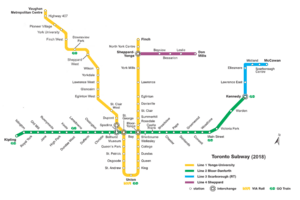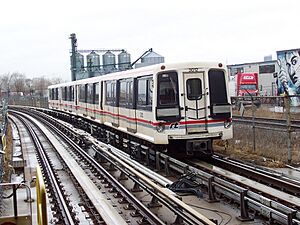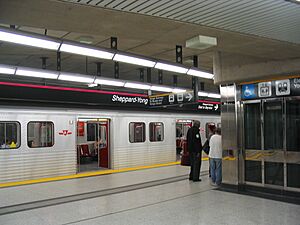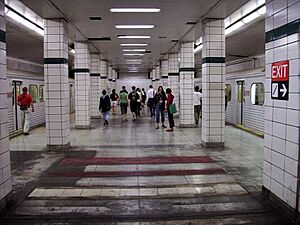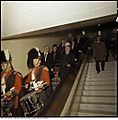Toronto subway and RT facts for kids
The Toronto subway and RT is a big railway system in Toronto, Ontario, Canada. It helps people travel quickly around the city. The Toronto Transit Commission (TTC) runs this system. It first opened in 1954 with 12 stations and has grown to be Canada's largest rapid transit railway.
Today, the Toronto subway has four main lines and 75 stations. It covers about 76.9 kilometers (47.8 miles) of track. Many people use the subway every day, making it the busiest system in Canada. On average, about 950,700 trips are made each weekday.
The subway system has been made bigger over the years. For example, the Yonge–University Line was extended north to places like York University and Vaughan Corporate Centre. This extension added about 8.6 kilometers (5.3 miles) of new track and six new stations. The Government of Ontario helped pay for this big project.
Quick facts for kids Toronto subway |
|||
|---|---|---|---|
 MuseumSubwayStation.jpg |
|||
| Info | |||
| Owner | City of Toronto (Lines 1, 2, 3 and 4) Metrolinx (Line 5) |
||
| Locale | Toronto, Canada | ||
| Transit type | Rapid transit | ||
| Number of lines | 4 (plus 2 under construction) | ||
| Number of stations | 75 (plus 39 under construction) | ||
| Daily ridership | 950,700 (avg. weekday, Q4 2016) |
||
| Operation | |||
| Began operation | March 30, 1954 | ||
| Operator(s) | Toronto Transit Commission (TTC) | ||
| Number of vehicles | 858 heavy rail and light metro cars, 66 work cars | ||
| Train length | 4 and 6 car train sets | ||
| Headway | 2 min 21 s–5 min 30 s (Lines 1, 2 and 4), 6 min 45 s (Line 3) | ||
| Technical | |||
| System length | 76.9 km (47.8 mi) 19 km (12 mi) (under construction) 6.2 km (3.9 mi) (approved) |
||
| Track gauge | 4 ft 10 7⁄8 in (1,495 mm) (Line 1, 2 and 4), 1,435 mm (4 ft 8 1⁄2 in) standard gauge (Line 3 and 5) | ||
| Electrification | 600 V DC Third rail (Line 1, 2 and 4), linear induction (Line 3), Overhead 750 V DC (Line 5) | ||
|
|||
Contents
Toronto's Subway Network: How It Works
The Toronto subway system is made up of different lines that connect many parts of the city. Each line has its own route and stations. The trains run underground in tunnels or sometimes above ground. This network helps thousands of people get to work, school, and other places every day.
History of the Toronto Subway
The first part of the subway opened in 1954. It replaced a very busy streetcar route. This first line followed Yonge Street from Eglinton Avenue south to Front Street. Then it turned west to end at Bay Street, near Union Station. This first section was 7.4 kilometers (4.6 miles) long.
In 1963, another part was added. It went north from Union Station, under University Avenue and Queen's Park. It ended near Bloor Street at St. George and Bloor Streets.
The Bloor-Danforth Line opened in 1966. It ran along Bloor Street and Danforth Avenue. This line was made longer in 1968. It then stretched from Islington Avenue to Warden station. An interesting fact is that when the Prince Edward Viaduct bridge was built in 1919, it was designed to hold future train lines underneath. This helped the subway cross the Don Valley easily.
The Yonge-University line was extended further north in 1973 and 1974. It added 8.7 kilometers (5.4 miles) of track, reaching Finch Avenue. More track was added to this line in 1978. It was extended north and northwest to Eglinton Avenue and Allen Road, then along Allen Road to Wilson Avenue.
In October 1976, a fire caused damage to subway cars and Christie station. This caused the Bloor-Danforth Line to close for three days. Christie station needed repairs for some time. More track was added to both ends of the Bloor-Danforth Line in 1980. These additions included new stations and bus areas.
The Scarborough RT is a special line. It has six stations on 6.8 kilometers (4.2 miles) of track. This line is mostly above ground and uses different trains called Intermediate Capacity Transit System (ICTS) trains. These trains are very different from the regular subway trains. The Scarborough RT is completely separate from road traffic and people walking.
Another 1.6 kilometers (1 mile) was added to the Spadina part of the Yonge-University-Spadina Line. This added one station, Downsview, with parking for buses.
In August 1995, there was a subway accident called the Russell Hill accident. It happened south of St. Clair West station. This was a very sad event.
The newest subway line, Sheppard, opened in 2002. It runs 5.5 kilometers (3.4 miles) east, under Sheppard Avenue. It goes from Sheppard station (now called Sheppard-Yonge) to Don Mills station. The Sheppard line is not as busy as the other lines and uses shorter trains.
In 2006, something unusual happened: the first baby was born on a TTC subway station platform! This happened at Wellesley station and caused some delays. It was big news for a few days.
An automatic voice system was added to the subway. It announces each station, like "The next station is Bloor, Bloor station." This means the train operator no longer has to announce each stop. This system is used throughout the entire subway and RT system.
Future Plans for the Subway
For a long time, the TTC mostly planned to build new rapid transit lines above ground, using streetcars in special lanes. But now, there are plans to build new subway lines underground. These plans include extending the Spadina-University line and adding two new lines in the central part of the city, south of Bloor-Danforth.
How the Subway Operates
Like most subways, Toronto's subway trains get their electricity from a third rail. This rail runs next to the tracks. Special metal pieces on the train, called 'shoes', touch this third rail to get power. The power supplied is 600 V DC.
A train guard is in charge of opening and closing the subway car doors. They make sure no one gets caught in a door as the train leaves a station. The guard tells the driver when it's safe to go. You can spot the guard's car by a white or orange light on the outside.
Hours and Frequency of Service
The subway runs from about 6:00 AM to 1:30 AM on weekdays and Saturdays. On Sundays, service starts later, at 9:00 AM. Holiday start times might be different.
| Line | Off-peak frequency | Rush hour frequency | |
|---|---|---|---|
| Bloor-Danforth | 4–5 minutes | 2–3 minutes | |
| Scarborough RT | 5–6 minutes | 4–5 minutes | |
| Sheppard | 5–6 minutes | 5–6 minutes | |
| Yonge-University-Spadina | 4–5 minutes | 2–3 minutes | |
Subway Stations
Most subway stations are named after the main roads that cross the subway line. Some are named after important landmarks nearby, like shopping centers or other transportation hubs.
All trains stop at every station along their route. They also run the entire length of their line, from one end to the other.
For a full list of stations, lines, and their locations, you can check the List of Toronto subway and RT stations.
Safety and Emergencies
The TTC has special services to keep everyone safe:
- TTC Special Constable Services are officers who help with security and some law enforcement on the subway.
- For other law enforcement needs, the Toronto Police Service is called.
- If there's a medical emergency, the Toronto EMS (Emergency Medical Services) handles it.
- For fires, the Toronto Fire Services respond.
Images for kids
-
Pieces of a tunnel boring machine extracted during the construction of Line 5 Eglinton, 2017
-
The Toronto Rocket uses orange LED signs to show stop announcements.
-
Most subway stations have places where you can connect to bus and streetcar services, like this one at Main Street station.
See also
 In Spanish: Metro de Toronto para niños
In Spanish: Metro de Toronto para niños


